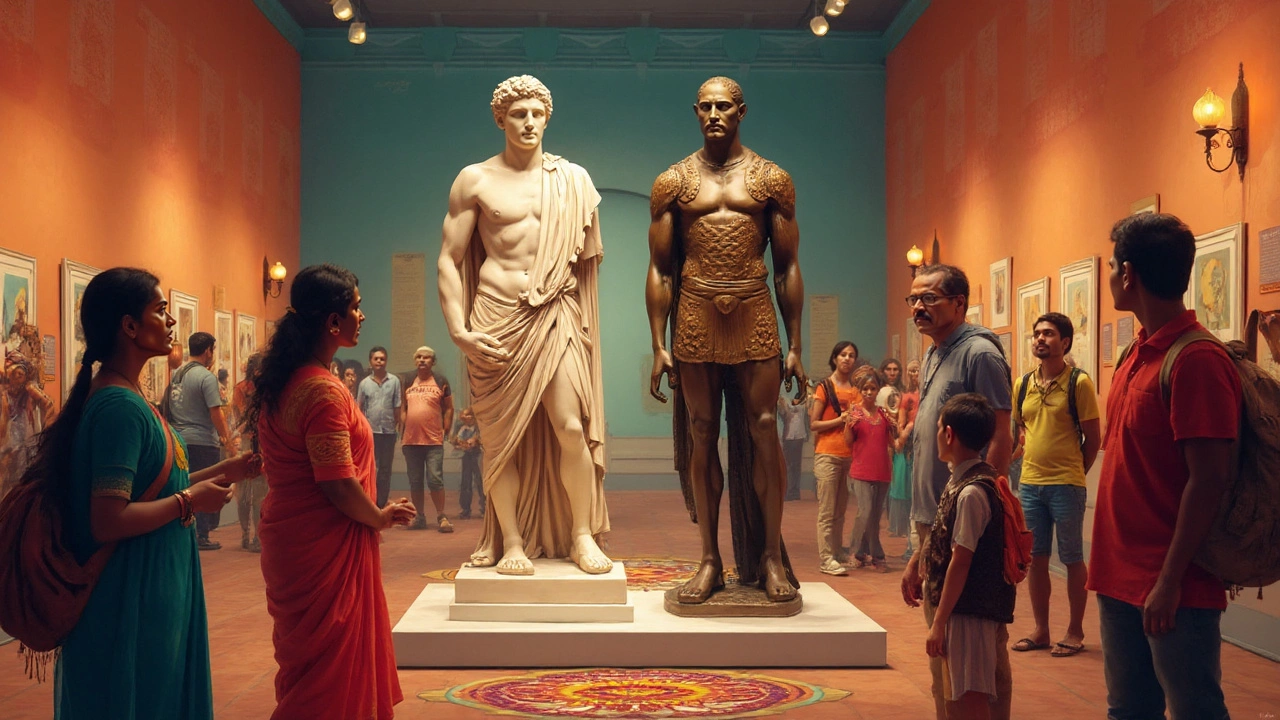Was Achilles Black or White? Unraveling the Myth’s True Appearance
 Sep, 25 2025
Sep, 25 2025
Achilles Appearance Quiz
1. In Homer's Iliad, what specific physical attribute of Achilles is NOT mentioned?
2. What skin tone is typically depicted in ancient Greek art for Achilles?
3. Which of the following best describes how ancient Greeks viewed ethnicity?
Achilles is a legendary Greek hero of the Trojan War, famed for his martial prowess and the fatal heel wound described in the Iliad. The question of his skin tone pops up every time the story is retold, especially in modern debates about race and representation. Below we dive into literary sources, visual evidence, scholarly interpretations, and what "race" meant in the ancient Mediterranean.
Literary Foundations: What Homer Says
Homer’s Iliad is a epic poem composed around the 8th centuryBC that narrates the final weeks of the Trojan War. Throughout the text, Achilles is described using athletic and heroic adjectives-"swift-footed," "radiant," "divine"-but never in terms of colour. Ancient Greek poetry rarely mentioned skin colour unless it was unusual (e.g., the "white" horses of Zeus). The omission suggests that colour was not a defining trait for Greek heroes.
Ancient Visual Culture: Art and Pottery
The surviving visual record-vase paintings, marble reliefs, and frescoes-offers the most direct clues. Most Classical and Hellenistic depictions show Achilles with the typical Mediterranean olive complexion seen in Greek art. Ancient Greek art tends toward a uniform palette of earthy flesh tones, ranging from light tan to medium brown. This style was more about artistic convention than realistic portraiture, yet deviations are rare. No surviving work shows Achilles with markedly dark (sub‑Saharan) or pale (Northern European) skin.
Ethnicity in the Ancient Mediterranean
When scholars talk about "ancient Greek ethnicity" they refer to a population that was ethnically diverse across the Aegean, Anatolia, and the western Levant. Ancient Mediterranean ethnicity encompassed a range of skin tones from light olive to darker brown, largely shaped by sun exposure and genetics. The concept of a rigid "race" as we know it today didn’t exist; identity was tied to city‑state, language, and mythic lineage. Therefore, assigning modern racial categories to Achilles is anachronistic.
Modern Scholarship on the "Race" Question
Recent studies in classical studies and anthropology have examined how contemporary concerns colour the reading of ancient texts. Modern scholarship on race investigates how concepts of race are projected onto ancient societies, often revealing more about modern anxieties than ancient realities. Scholars such as Dr. Sarah C. Brown (University of Oxford) argue that the "black or white" debate stems from a desire to claim cultural icons for modern identity politics rather than solid evidence.

Comparing Textual and Visual Evidence
| Source Type | Typical Description | Implied Skin Tone | Interpretation |
|---|---|---|---|
| Homeric Texts (Iliad) | Radiant, swift‑footed, divine | Not specified; likely Mediterranean | Poetic focus on heroism, not colour |
| Classical Vase Paintings | Standard flesh tone, limited shading | Olive‑to‑light brown | Artistic convention, reflects Greek norms |
| Hellenistic Marble Reliefs | Detailed musculature, subtle shading | Medium tan | Aim for realism within Greek palette |
| Modern Film & TV Adaptations | Varies-white, mixed, or black actors | Depends on casting choice | Reflects contemporary cultural agendas |
Why the Debate Persists
Two main forces keep the question alive. First, the hero’s status as a cultural touchstone means different groups want to see themselves reflected in his story. Second, the lack of explicit ancient description creates a vacuum that modern imagination readily fills. As long as media reinterpretations continue, the conversation will stay vibrant.
Related Concepts and Further Reading
Understanding Achilles’ appearance also opens doors to other fascinating topics:
- Trojan War mythic conflict between Greeks and Trojans, central to the Iliad
- Greek hero cults religious practices honoring legendary figures like Achilles
- Myrmidons the elite infantry commanded by Achilles
- Patroclus Achilles' close companion whose death spurs the hero’s wrath
Each of these angles sheds light on how ancient Greeks constructed identity, honor, and visual storytelling.
Practical Takeaway for Readers
If you’re writing a paper, creating a costume, or simply curious, keep these rules in mind:
- Base visual choices on Mediterranean flesh tones unless your project explicitly re‑imagines the myth.
- Lcite ancient sources (Homer, vase painting catalogues) to justify colour decisions.
- Acknowledge the modern interpretive layer if you opt for non‑traditional casting.
In short, the most evidence‑backed answer is that Achilles likely looked like a typical Greek of his era-olive‑to‑light brown skin-though the ancient record is silent on exact hue. The Achilles skin color debate remains a modern mirror reflecting our own cultural concerns.
Frequently Asked Questions
Did Homer ever describe Achilles' skin colour?
No. Homer focuses on Achilles' speed, bravery, and divine lineage. Physical colour is never mentioned, which was typical for epic poetry of the era.
What do surviving Greek artworks show?
Vase paintings, reliefs, and statues portray Achilles with the standard Greek flesh tone-light to medium tan. Artists adhered to a conventional palette rather than realistic portraiture.
Could Achilles have been dark‑skinned?
While the ancient Mediterranean population included a range of complexions, the textual and visual evidence does not point to a markedly dark complexion. Any claim would be speculative.
Why does the modern debate matter?
Achilles is an archetypal hero. Contemporary societies often look to such figures for representation. The debate highlights how we project modern identity politics onto ancient narratives.
Are there any ancient texts that discuss race?
Ancient Greeks had concepts of "barbarians" versus "Hellenes," but these were cultural rather than racial. Physical colour was rarely a factor in their ethnographic descriptions.